American Motors Corporation (AMC) was an American automobile company formed by the merger of Nash-Kelvinator Corporation and Hudson Motor Car Company on 1 May 1954. At the time, it was the largest corporate merger in U.S. history.[3]
AMC went on to compete with the U.S. Big Three—Ford, General Motors and Chrysler—with its small cars including the Rambler American, Hornet, Gremlin and Pacer; its intermediate and full-size cars including the AMC Ambassador, AMC Rebel, and AMC Matador; muscle cars including the Marlin, AMX and Javelin; and early four-wheel-drive variants of the Eagle, the U.S. market’s first true crossover.
The company was known as “a small company deft enough to exploit special market segments left untended by the giants”,[4] and was widely known for the design work of chief stylist, Dick Teague, who “had to make do with a much tighter budget than his counterparts at Detroit’s Big Three” but “had a knack for making the most of his employer’s investment”.[5]
After periods of intermittent but unsustained success, Renault acquired a major interest in AMC in 1979—and the company was ultimately acquired by Chrysler. At its 1987 demise, The New York Times said AMC was “never a company with the power or the cost structure to compete confidently at home or abroad.”[6]
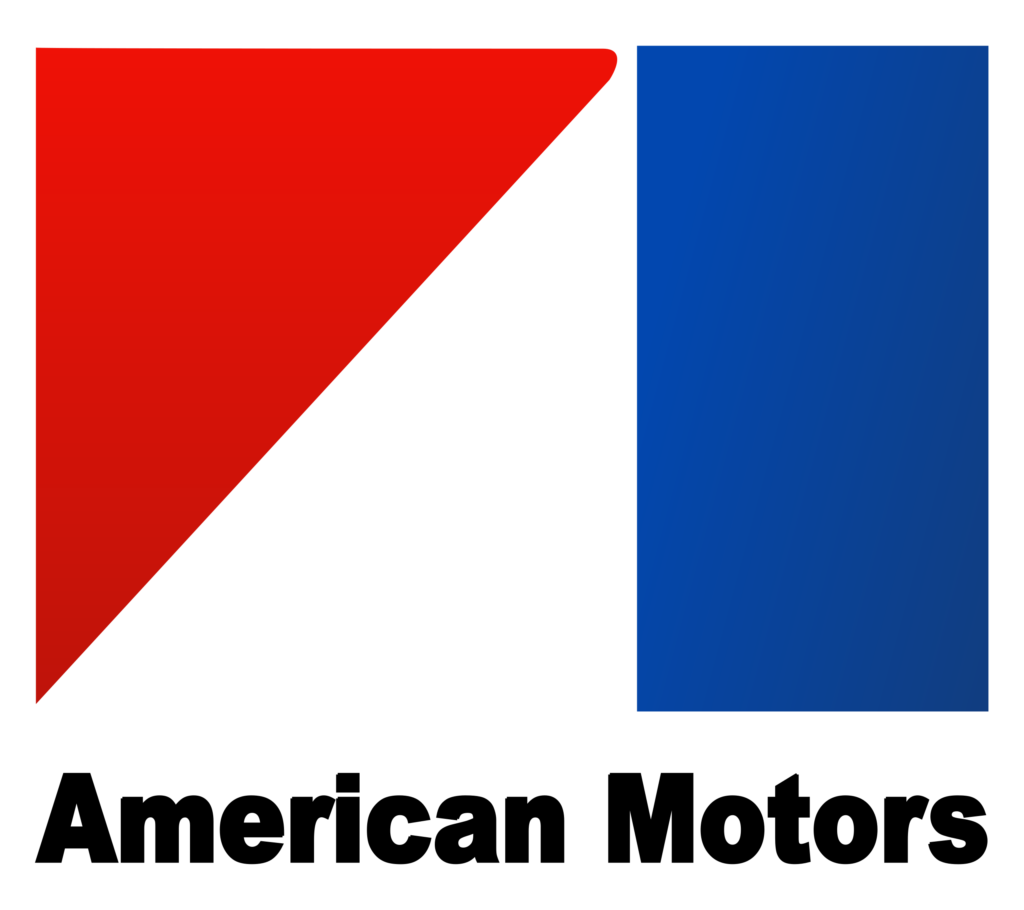
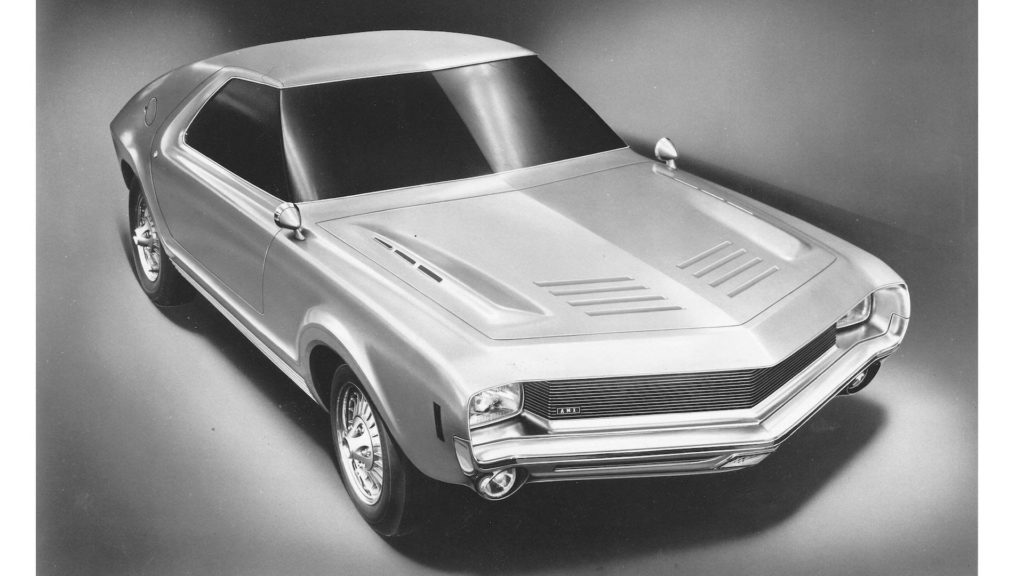
The 1954 merger of Nash-Kelvinator Corporation and Hudson Motor Car Company, and the creation of American Motors, was led by Nash-Kelvinator president George W. Mason to reap benefits from the strengths of the two firms to battle the much larger “Big Three” automakers (General Motors, Ford, and Chrysler). The merger was intended to be the first step of amalgamating the Nash, Hudson, Studebaker, and Packard marques into a single company. The plan was for Nash to acquire Hudson and for Packard to acquire Studebaker, then merge the four marques into one.[7] Mason had first discussed the possibility of a merger with Packard president James J. Nance in the late 1940s. Packard acquired Studebaker two months after Nash acquired Hudson.[8]
Mason became CEO and president of the new company and Hudson president A.E. Barit retired to become an AMC board member. Mason selected long-time Nash associate and future governor of Michigan, George W. Romney as Vice president. Roy Abernethy, ex Vice president of Sales for Willys, was hired to be Vice president of Sales for AMC.
Following Mason’s sudden death on October 8, 1954, Romney took over, reorganizing the company and focusing AMC’s future on a new small car line.[9] Mason’s death also allowed Romney to put an end to any further discussions for a merger between AMC and Studebaker-Packard.
By the end of 1957, the legacy Nash and Hudson brands were completely phased out, replaced with the Rambler and Metropolitan brands. The company struggled at first, but under Abernethy, Rambler sales took off. A Rambler won the 1959 Mobil Economy Run and by 1960, was the third most popular brand of automobile in the United States, behind Ford and Chevrolet.[10][11]
George Romney left AMC in 1962 to run for governor in Michigan and was replaced as CEO by Roy Abernethy. After two model years (1963 and 1964) of only producing compact cars, Abernethy shifted the focus of AMC back to larger and more profitable cars like the Ambassador line from the perceived negative of the Rambler’s economy car image. Ambassador sales jumped from 18,647 in 1964 to over 64,000 in 1965. In 1966 they went to more than 71,000.[12]However, the huge costs of developing the new cars and engines meant AMC now had problems in securing working capital to keep the company going. AMC sales dropped twenty percent in the first half of 1966, and the firm reported a fiscal six-month loss of $4.2 million on sales of $479 million. Consequently, Robert B. Evans invested more than US$2 million because AMC’s stock was selling for only 60 percent of the company’s net worth; thus he became its largest stockholder and was named its chairman on June 6, 1966, replacing Richard E. Cross, who continued as a director and chairman of the executive committee.[13] The last quarter sales for AMC ended September 30, 1966. AMC recorded a loss of $12,648,000 for the year before Tax Credits and deferred Tax Assets. In the face of deteriorating financial and market positions, Abernethy was “retired” as CEO in 1967 and Evans “resigned” as chairman. Abernethy was replaced by the son of Hudson co-founder Roy D. Chapin, Roy D. Chapin, Jr.[14] and Evans was replaced by William V. Luneberg. AMC’s public explanation for the removals was that the two had “stepped aside according to a plan to give a younger team an opportunity to move the company forward”.[15]
Chapin took charge to revitalize the company, and designer Richard A. Teague economized by developing several vehicles from common stampings. While prices and costs were cut, new and more sporty automobiles were introduced, and from 1968 AMC became known for the Javelin and AMX muscle cars.
AMC purchased Kaiser‘s Jeep utility vehicle operations in 1970 to complement its existing passenger car business. Beginning in the early 1970s, the company moved towards all-new compact car designs based on the Hornet, including the Hornet itself and the Gremlin. Other new models in the 1970s included the Matador and Pacer. Sagging sales and tight finances resulted in the elimination of the Matador line in the 1979 model year and the Pacer line in 1980, leaving AMC to focus almost exclusively on its Hornet platform based cars and the Jeep line. Hornet derivatives of the late 1970s included the Spirit and Concord, while the innovative 4-wheel-drive AMC Eagle introduced in 1979 was one of the first true crossovers.
From 1980, AMC partnered with France’s Renault to help finance their manufacturing operations, obtain much-needed capital, and source subcompact vehicles. By 1983 Renault had a controlling interest in AMC. After the 1983 model year, the AMC brand focused entirely on AWD autos; the company stopped producing two-wheel drive cars. AMC facilities were used to produce the Renault-branded Alliance and Encore compact and subcompact cars. In 1985 Chrysler entered an agreement with AMC to produce Dodge Diplomats and Plymouth Furys as well as Dodge Omnis and Plymouth Horizons in AMC’s Kenosha, Wisconsin plant. At the time, AMC had excess manufacturing capacity, thus contract manufacturing for Chrysler made sense. In 1987, after further new vehicle development that included the Medallion (a re-badged Renault 21) and Giorgetto Giugiaro‘s Italdesign new full-size front-drive sedan that became the Eagle Premier,[16][17] Renault sold its 47% ownership stake in AMC to Chrysler. Chrysler made a public offer to purchase all the remaining outstanding shares of AMC stock on the NYSE. Renault left the US market completely as a brand in 1987. The Renault Medallion was sold through the newly formed Jeep Eagle Division of Chrysler as an Eagle, not a Renault. AMC’s badge would be used on the Eagle Sports Wagon through the 1988 model year, then be eliminated entirely. The Jeep/Eagle division of Chrysler Corporation was formed from the AMC Jeep Renault dealer network. The Jeep and Eagle vehicles were marketed primarily by former AMC dealers. Ultimately, the Eagle Brand of car would be phased out like Chrysler’s DeSoto, Plymouth, and Imperial by 1998.
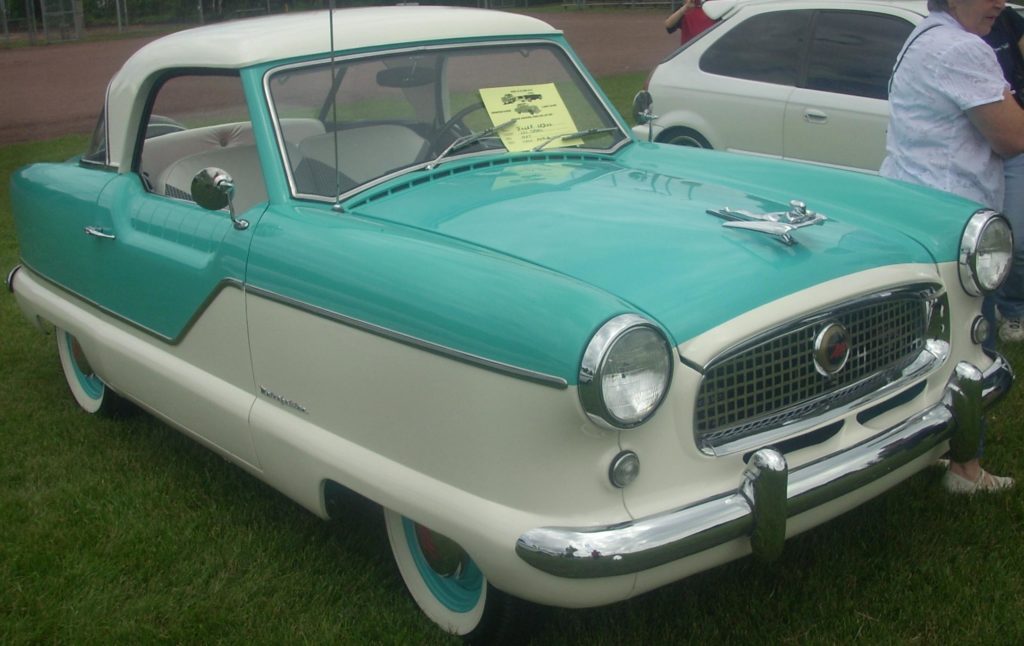
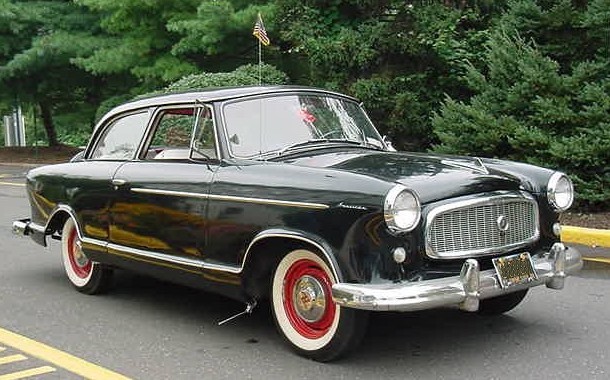
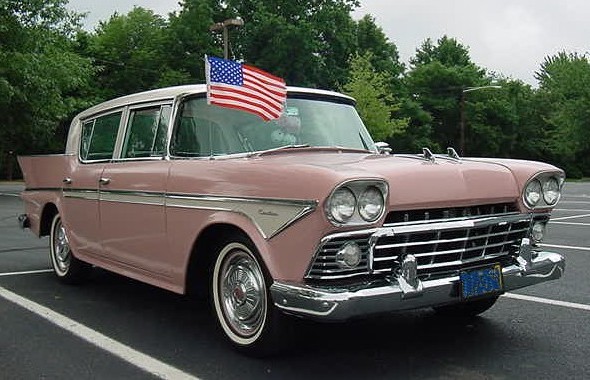
Product development in the 1950s
Product consolidation
American Motors combined the Nash and Hudson product lines under a common manufacturing strategy in 1955, with the production of Nashes and Hudsons consolidated at the Nash plant in Kenosha.[26] The Detroit Hudson plant was converted to military contract production and eventually sold. The separate Nash and Hudson dealer networks were retained. The Hudsons were redesigned to bring them in harmony with Nash body styles.
The fast-selling Rambler model was sold as both a Nash and a Hudson in 1955 and 1956. These badge-engineered Ramblers, along with similar Metropolitans, were identical save for hubcaps, nameplates, and other minor trim details.
The pre-existing full-size Nash product line was continued and the Nash Statesman and Ambassador were restyled as the “new” Hudson Wasp and Hudson Hornet. Although the cars shared the same body shell, they were at least as different from one another as Chevrolet and Pontiac. Hudsons and Nashes each used their own engines as they had previously: the Hudson Hornet continued to offer the 308 cu in (5.0 L) I6 that had powered the (NASCAR) champion during the early 1950s; the Wasp now used the former engine of the Hudson Jet.
The Nash Ambassador and Statesman continued with overhead- valve and L-head sixes respectively. Hudson and Nash cars had different front suspensions. Trunk lids were interchangeable but other body panels, rear window glass, dash panels and braking systems were different. The Hudson Hornet and Wasp, and their Nash counterparts, had improved ride and visibility; also better fuel economy owing to the lighter unitized Nash body.
For the 1958 model year, the Nash and Hudson brands were dropped. Rambler became a marque in its own right and the mainstay of the company. The popular British-built Metropolitan subcompact continued as a standalone brand until it was discontinued in 1961. The prototype 1958 Nash Ambassador / Hudson Hornet, built on a stretched Rambler platform, was renamed at the last minute as “Ambassador by Rambler”. To round out the model line AMC reintroduced the old 1955, 100 in (2,540 mm) wheelbase Nash Rambler as the new Rambler American with only a few modifications. This gave Rambler a compact lineup with 100 in (2,540 mm) American, 108 in (2,743 mm) Rambler Six and Rebel V8, as well as the 117 in (2,972 mm) Ambassador wheelbase vehicles.
The “dinosaur-fighter”
Sales of Ramblers soared in the late 1950s in part because of American Motors’ focus on the compact car and its marketing efforts. These included sponsoring the hugely popular Walt Disney anthology television series and as an exhibitor at the Disneyland theme park in Anaheim, California. George Romney himself pitched the Rambler product in the television commercials.
While the “Big Three” introduced ever-larger cars, AMC followed a “dinosaur-fighter” strategy. George W. Romney‘s leadership focused the company on the compact car, a fuel-efficient vehicle 20 years before there was a real need for them.[29] This gave Romney a high profile in the media. Two core strategic factors came into play: (1) the use of shared components in AMC products and (2) a refusal to participate in the Big Three’s restyling race. This cost-control policy helped Rambler develop a reputation as solid economy cars. Company officials were confident in the changing market and in 1959 announced a $10 million (US$85,947,489 in 2016 dollars[30]) expansion of its Kenosha complex (to increase annual straight-time capacity from 300,000 to 440,000 cars).[31] A letter to shareholders in 1959 claimed that the introduction of new compact cars by AMC’s large domestic competitors (for the 1960 model year) “signals the end of big-car domination in the U.S.” and that AMC predicts small-car sales in the U.S. may reach 3 million units by 1963.[31]
American Motors was also beginning to experiment in non-gasoline powered automobiles. On April 1, 1959, AMC and Sonotone Corporation announced a joint research effort to consider producing an electric car that was to be powered by a “self-charging” battery.[32] Sonotone had the technology for making sintered plate nickel–cadmium batteries that can be recharged very rapidly and are lighter than a typical automobile lead–acid battery.[33]
In 1959, AMC hired designer Richard A. Teague who had previously worked for General Motors, Packard, and Chrysler; after Edmund E. Anderson left the company in 1961, Teague was named principal designer and in 1964, Vice President.

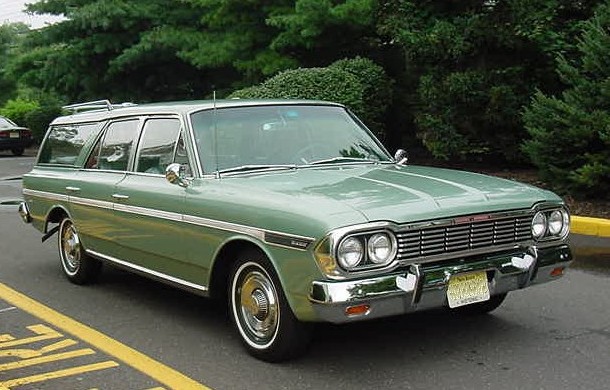
Changing focus in the 1960s
Innovation
In an effort to stay competitive, American Motors produced a wide range of products during the 1960s and added innovations long before the “Big Three” introduced them.
For example, the Rambler Classic was equipped with a standard tandem master cylinder in 1962 that provided stopping ability even if there was a failure in the brake system.[34] Only Cadillac also included this safety feature six years before U.S. safety regulations required it on all cars.
Rambler also was an early pioneer in offering an automatic shift indicator sequence (P R N D2 D1 L, where if one selected “D2”, the car started in second gear, while “1” started in first gear) on its “Flash-O-Matic” transmission which is similar to today’s “PRNDSL” shift pattern, made mandatory for the 1968 model year cars,[35] which required a neutral position between reverse and drive,[36] while General Motors still offered a shift selector that had reverse immediately next to low gear (PNDSLR) well into the 1960s.
Unique in the domestic automotive industry, AMC offered adjustable front seat backrests from their Nash-origin,[37] and in 1964, the Classic and Ambassador were equipped with standard dual reclining front seats nearly a decade before the Big Three offered them as options. Bendix disc brakes were made standard on the Marlin and optional on other models in 1965.[38][39] This made the Marlin one the first modern American cars with standard disc brakes, while the Big Three did not offer them until the early 1970s on most of their models to meet Federal Motor Vehicle Safety Standards.[40]
In the early part of the decade, sales were strong, thanks in no small part to the company’s history of building small cars, which came into vogue in 1961.[41] In both 1960 and 1961, Ramblers ranked in third place among domestic automobile sales,[42] up from third on the strength of small-car sales, even in the face of a lot of new competition.[41] Romney’s strategic focus was very successful as reflected in the firm’s healthy profits year after year. The company became completely debt-free. The financial success allowed the company to reach an agreement on August 26, 1961, with the United Auto Workers for a profit sharing plan that was new in the automobile industry. Its new three-year labor contract also included generous annual improvement pay increases, as well as automatic cost-of-living raises.[43]However, in 1962, Romney resigned to run for Governor of Michigan. His replacement was Roy Abernethy, AMC’s successful sales executive.
Abernethy believed that AMC’s reputation of building reliable economical cars could be translated into a new strategy that could follow AMC buyers as they traded up into larger, more expensive vehicles. AMC, in reality, had produced large cars throughout most of its history, The Rambler Ambassadors were every bit as large as a full-sized Ford or Chevy. There was only an absence of largest sized cars from the AMC lineup in 1963 and 1964[44] The first cars bearing his signature were the 1965 models. These were a longer Ambassador series and new convertibles for the larger models. During mid-year a fastback, called the Marlin, was added. It competed directly with cars like the Dodge Charger, AMC’s “family-sized” car emphasized personal-luxury. Abernethy also called for the de-emphasis of the Rambler brand, because he believed the public associated it too strongly with economy cars, and that it was hindering the sale of AMC’s other models at a time when mid and luxury car sales was very strong. As a result, he ordered that for 1966, the Ambassador and Marlin were to be badged purely as a product of American Motors Corporation.[45] This was followed by the 1968 Rebel. The new models shared fewer parts among each other and were more expensive to build.
Tough choices
The continuing quest “in the business world’s toughest race – the grinding contest against the Big Three automobile makers” also meant annual styling changes requiring large expenditures.[46] American Motors’ management total confidence “that the new 1965 models would stem a bothersome decline” actually began falling behind in share of sales.[47] Moreover, a new line of redesigned cars in the full and mid-sized markets was launched in the fall of 1966.[48] The cars won acclaim for their fluid styling, and Abernethy’s ideas did work as Ambassador sales increased significantly. The dated designs of the Rambler Americans, however, hurt its sales which offset gains from Ambassador sales. There were quality control problems with the introduction of the new full-sized cars, as well as persistent rumors of the company’s demise because of their precarious cash flow. Consumer Reports negative ratings for AMC’s Safety didn’t help either.
American Motors did not have their own electric car program as did the Big Three, and after some negotiation a contract was drawn in 1967 with Gulton Industries to develop a new battery based on lithium and a speed controller designed by Victor Wouk.[49] A nickel-cadmium battery powered 1969 Rambler station wagon demonstrated the power systems that according to the scientist was a “wonderful car”.[49] This was also the start of other “plug-in”-type experimental AMC vehicles developed with Gulton – the Amitron and the Electron.
Abernethy was ousted from AMC on January 9, 1967, and damage control fell to the new CEO, Roy D. Chapin Jr. (son of Hudson Motors founder Roy D. Chapin).[50]Chapin quickly instituted changes to AMC’s offerings and tried to regain market share by focusing on younger demographic markets.[51] Chapin’s first decision was to cut the price of the Rambler to within US$200 of the basic Volkswagen Beetle. Innovative marketing ideas included making air conditioning standard on all 1968 Ambassador models (available as a delete option). This made AMC the first U.S. automaker to make air conditioning standard equipment on a line of cars, preceding even luxury makes such as Lincoln, Imperial, and Cadillac.
The company introduced exciting entries for the decade’s muscle car boom, most notably the AMX, while the Javelin served as the company’s entrant into the sporty “pony car” market created by the Ford Mustang. Additional operating cash was derived in 1968 through the sale of Kelvinator Appliance, once one of the firm’s core operating units. The Kelvinator divestiture left AMC a downsized company solely manufacturing automobiles.
The Rambler brand was completely dropped after the 1969 model year in North America, although it continued to be used in several overseas markets as either a model or brand name, with the last use in Mexico in 1983. From 1970, AMC was the brand used for all American Motors passenger cars; and all vehicles from that date bore the AMC name and the new corporate logo. However, the names American Motors and AMC were used interchangeably in corporate literature well into the 1980s. The branding issue was further complicated when the company’s Eagle all-wheel drive passenger cars were marketed as the American Eagle in the 1980s.
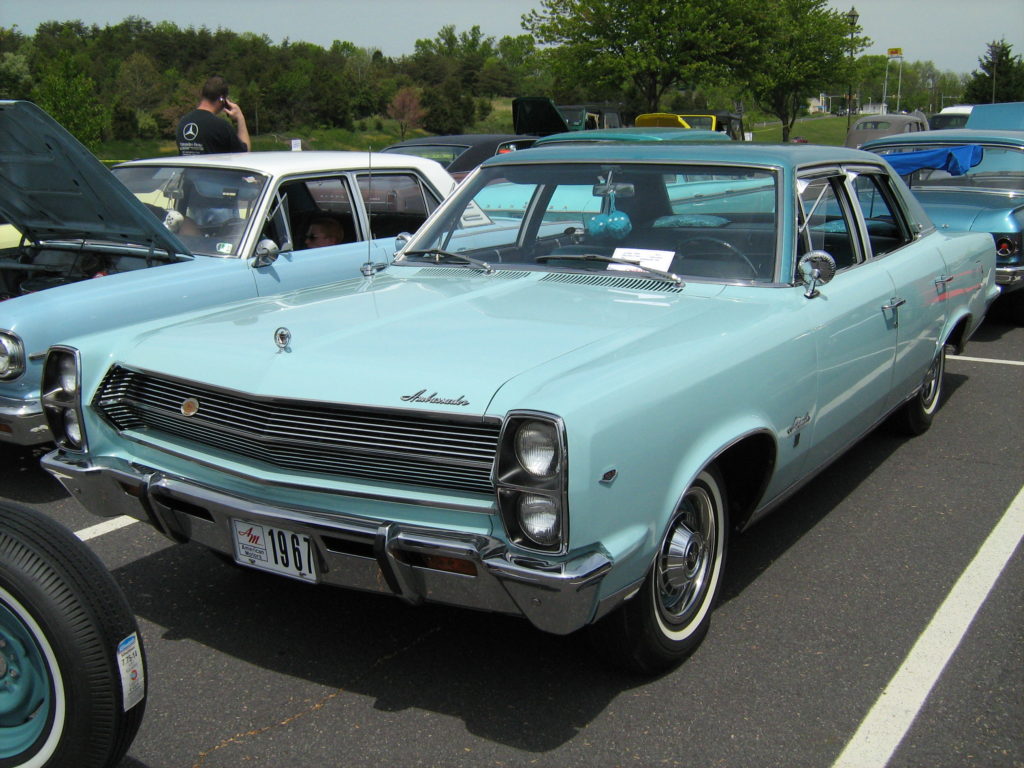
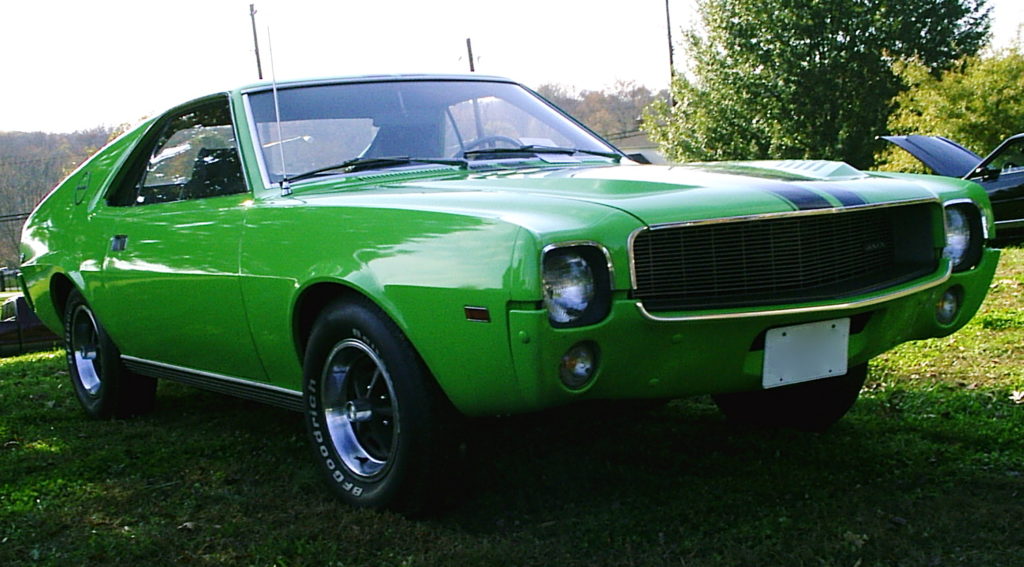
In the late 1960s Kaiser Jeep Corporation (formerly Willys-Overland) decided to leave the automotive industry and sought a buyer for its money-losing Jeep division. AMC’s Vice President for Manufacturing, Gerald C. Meyers headed the team sent to evaluate Kaiser’s Jeep factories. Although opposed by AMC top management, Chapin made a major decision in February 1970 to purchase Kaiser’s Jeep operations for $70 million. Although it was a gamble Chapin believed that Jeep vehicles would complement AMC’s passenger car business. The Jeep market was also a market in which the Big Three had no presence, and therefore there was no competition. AMC gained the iconic Jeep brand of light trucks and SUVs, as well as Kaiser-Jeep’s government contracts – notably the M151 line of military Jeeps and the DJ-Series postal Jeeps. AMC also expanded their international network. The military and special products business was reconstituted as American Motors General Products Division, later reorganized as AM General.
Hornet and Gremlin
In 1970, AMC consolidated all passenger cars under one distinct brand identity and debuted the Hornet range of compact cars. The Hornet and the later Gremlinshared platforms. The Gremlin, the first North American-built subcompact, sold more than 670,000 units from 1970 to 1978. The Hornet became AMC’s best-selling passenger car since the Rambler Classic, with more than 860,000 units sold by the time production ended in 1977. The Hornet platform continued to be built under a variety of models through 1987.
Matador
The new face-lifted, mid-sized AMC Matador replaced the Rebel in 1971, using an advertising campaign that asked, “What’s a Matador?”[52] In 1972, AMC won the tender for Los Angeles Police Department cruisers, and Matadors were used by the department from 1972 to 1975, replacing the Plymouth Satellite. American Motors supplied Mark VII Limited owner Jack Webb with two Matadors, a sedan and a wagon, for use in his popular television series Adam-12, increasing the cars’ public profile.
In 1973, AMC signed a licensing agreement with Curtiss-Wright to build Wankel engines for cars and Jeeps.[53]
Matador Coupe
Starting in 1974, the Matador sedan and station wagon were mildly refreshed, with new boxier front ends. The Matador two-door hardtop, known as the “flying brick” due to its poor aerodynamics in NASCAR competition, was replaced at great cost with a sleek, smoothly shaped, and radically styled two-door coupe. The model received praise for its design, including “Best Styled Car of 1974” by Car and Driver magazine,[54] customer satisfaction,[55] and sold almost 100,000 coupes over a five-year period.[56] The Matador Coupe shared few components with the Matador sedan and station wagon other than suspension, drive train, some trim, and interior parts.
Ambassador
The Ambassador was redesigned and stretched 7 inches (178 mm) to become the biggest ever, just as the 1973 Arab Oil Embargo sparked gasoline rationing across the nation. The additional length was due to a new front end design and stronger energy-absorbing bumpers required of all automobiles sold in the U.S.[57] Sales of all large cars fell due to economic problems and rising gasoline prices. The full-sized Ambassador was discontinued as AMC’s flagship line after the 1974 model year. Nash and AMC made Ambassadors from 1927 to 1974, the longest use of the same model name for any AMC product and, at the time, the longest continuously used nameplate in the industry.
Metropolitan Buses
In 1974, AMC’s AM General subsidiary began building urban transit buses in cooperation with Flyer Industries of Winnipeg, Manitoba. The Metropolitan coach had sold 5,212 units when production ceased in 1978.[58]
Pacer
The AMC Pacer, an innovative all-new model introduced in March 1975 and marketed as “the first wide small car”, was a subcompact designed to provide the comfort of a full-sized car. Its pre-production development coincided tightened U.S. Federal passenger emissions and auto safety regulations.
With the Arab Oil Embargo of 1973, General Motors aborted the Wankel rotary engine around which the Pacer had been designed, as its fuel consumption exceeded that of conventional engines with similar power. Therefore, AMC’s existing 258 and 232 cu in (4.2 and 3.8 L) AMC Straight-6 engines were used in the Pacer instead. Fuel economy was better than a rotary but still relatively poor in light of the new focus on energy efficiency. Also, as the Pacer shared few components other than drivetrain with other AMC cars, it was expensive to make and the cost increased when sales fell steeply after the first two years.[original research?]
Development and production costs for the Pacer and Matador Coupe drained capital which might otherwise have been invested in updating the more popular Hornet and Gremlin lines so that toward the end of the 1970s the company faced the growing energy crisis with aged products that were uncompetitive in hotly contested markets. However, “AMC used cars, as far back as 1967, had the advantage of good warranty coverage … so most owners were conscious of low-cost car maintenance … AMC units [became] some of the very best buys on the used car market” by 1975.[59]
The 1977 Gremlin had redesigned headlights, grille, rear hatch and fascia. For economy in the fuel crisis, AMC offered the car with a more fuel-efficient Volkswagen-designed Audi 4-cylinder engine 2.0 L (122 cu in). The engine was expensive for AMC to build and the Gremlin retained the less costly but also less economical 232 cu in (3.8 L) as standard equipment.
The AMX nameplate was revived in 1977. It was a sporty appearance package on the Hornet hatchback featuring upgrades, as well as the 258 cu in (4.2 L) inline six as standard with a choice of three-speed automatic or four-speed manual transmissions.[60] The 304 cu in (5.0 L) V8 engine was optional with the automatic transmission.
As all Matadors now received standard equipment that was formerly optional (e.g. power steering, automatic transmission), the “Brougham” package was dropped. Optional on the Matador coupe was a landau vinyl roof with opera windows, and top-line Barcelonas offered new two-tone paint.
Concord
For 1978, the Hornet platform was redesigned with an adaptation of the new Gremlin front-end design and renamed AMC Concord. AMC targeted it at the emerging “premium compact” market segment, paying particular attention to ride and handling, standard equipment, trim, and interior luxury.[61]
Gremlins borrowed the Concord instrument panel, as well as a Hornet AMX-inspired GT sports appearance package and a new striping treatment for X models.
The AMC Pacer hood was modified to clear a V8 engine, and a Sports package replaced the former X package. With falling sales of Matador Coupes, sedans and wagons, their 304 cu in (5.0 L) V8 engine was dropped, leaving only the 258 cu in (4.2 L) Inline-6 (standard on coupes and sedans) and the 360 cu in (5.9 L) V8 (optional on coupes and sedans, standard on wagons). The two-tone Barcelona luxury package was offered on Matador sedans, and two-tone red paint introduced as an additional Barcelona option. Matador production ceased at the end of the model year with total sales of 10,576 units. The Matador was no longer attractive as automakers struggled to overcome economic woes including continuing fuel price increases and double-digit domestic inflation.[62]
Spirit
In 1979, the Spirit sedan replaced the Gremlin. A new fastback version of the car, the Spirit Liftback, proved successful.
In December, Pacer production ceased after a small run of 1980 models was built to use up parts stock.
Concords received a new front end treatment, and in their final season, hatchbacks became available in DL trim. On May 1, 1979, AMC marked the 25th anniversary of the Nash-Hudson merger with “Silver Anniversary” editions of the AMC Concord and Jeep CJ in two-tone silver (Jeeps then accounted for around 50 percent of the company’s sales and most of their profits); and introduced LeCar, a U.S. version of the small, fuel-efficient Renault 5, in dealer showrooms.[63]
Concord and Spirit models were dropped after 1983.
Late 1970s
In February 1977, Time magazine reported that although AMC had lost $73.8 million in the previous two fiscal years, U.S. banks had agreed to a year’s extension for a $72.5 million credit that had expired in January; that Stockholders had received no dividends since 1974; and that Pacer sales did not match expectations. However, Time noted record Jeep sales and a backlog of orders for AM General’s buses.[64]
On 21 October 1977, Roy Chapin Jnr. retired and Gerald C. Meyers became Chairman and CEO.[65]
On March 31, 1978, AMC and Renault announced a sweeping agreement for the joint manufacture and distribution of cars and trucks that would achieve benefits for both.[66] A month later, AMC announced that it would halt the production of standard urban transit buses after about 4,300 were sold by its AM General subsidiary over a period of three years.[67] In May 1978, the U.S. Environmental Protection Agency ordered the recall of all AMC’s 1976 cars (except those conforming to California emissions regulations) – some 270,000 vehicles— plus 40,000 1975 and 1976 Jeeps and mini trucks, for correction of a fault in the pollution control system. Total cost was estimated at up to $3 million—more than AMC had earned the previous quarter.[68]
American Motors lost an estimated $65 million on its conventional (non-Jeep) cars for the fiscal year ended September 30, 1978, but strong Jeep sales helped the company to an overall $36.7 million profit on sales of $2.6 billion. However, AMC faced costly engineering work to bring their Jeeps into compliance with a federal directive for all 4-wheel-drive vehicles to average 15 mpg‑US (16 L/100 km; 18 mpg‑imp) by 1981.[69]
A year later, with its share of the American market at 1.83%, the company struck a deal with Renault, the nationally owned French automaker. AMC would receive a $150 million cash injection, $50 million in credits, and also the rights to start building the Renault 5 in 1982.[70] (A deal for Renault products to be sold through the AMC-Jeep dealer network had already been made in 1979).[71] In return, Renault acquired a 22.5% interest in AMC.[70] This was not the first time the two companies had worked together. Lacking its own prestige model line in the early 1960s, Renault assembled CKD kits and marketed Rambler cars in France.[72]
In 1979, AMC announced a record $83.9 million profit on sales of $3.1 billion (US$10,701,467,217 in 2018 dollars[30]) for the fiscal year ending in September—this despite an economic downturn, soaring energy prices, rising American unemployment, automobile plants shutting down, and an American market trend towards imported cars. In October, the company’s car sales surged 37%, while they sank 21% for the industry as a whole.[73]
1980s
In 1980, all American Motors cars received a new rust-proofing process called Ziebart Factory Rust Protection. This included aluminized trim screws, plastic inner fender liners, galvanized steel in every exterior body panel, and a deep-dip (up to the window line) bath in epoxy-based primer. AMC backed up the rust protection program with a 5-year “No Rust Thru” component to its comprehensive “Buyer Protection Plan”.[11]
A drop in Jeep sales caused by the declining economy and soaring energy prices began to constrict AMC’s cash flow. At the same time, pressure increased on the company’s non-Jeep product lines. The face-lifts and rebranding of AMC’s once-innovative and successful cars were not enough in a competitive landscape that had changed dramatically. No longer was the threat limited to the Big Three automakers (General Motors, Ford, and Chrysler). The Japanese manufacturers (Honda, Toyota, Nissan) used streamlined production methods such as outsourcing and Just In Time (JIT) supply-chain management. They had new, highly efficient assembly plants in the United States. And now they targeted the heart of AMC’s passenger product line: small cars.
While Americans turned to the new imports in increasing numbers, AMC continued its struggle at the inefficient and aging Kenosha, Wisconsin facilities—the oldest continuously operating automobile plant in the world, where components and unfinished bodies still had to be transported across the city.
In early 1980, the banks refused AMC further credit. Lacking both capital and resources for the new, truly modern products it needed to offer, the company turned to Renault for a $90 million loan (US$273,671,244 in 2018 dollars[30]).[74] By September that year, AMC’s U.S. market share had fallen to 1.7%, and in November sales dropped 19.1%. AMC warned stockholders that the company could be bankrupted if they did not approve a plan for Renault to acquire as much as 59% of the company.[75] On December 16, 1980, AMC shareholders “overwhelmingly approved making the French Government-owned Renault” their company’s principal owner.[76] Jean-Marc Lepeu, former corporate treasurer at Renault, became vice president for finance at AMC. In September 1981, Jose Dedeurwaerder, a Renault veterans of 23 years, mainly in manufacturing, became AMC’s executive vice president for manufacturing.[77]
In January 1982 the company’s former president W. Paul Tippett Jr. replaced Gerald C. Meyers as chairman and CEO, and Dedeurwaerder moved up to president.[78] By this time Renault owned 46% of AMC. Dedeurwaerder brought a broad perspective at this critical time: he is credited with streamlining many of AMC’s arcane management techniques. He also instituted important improvements in plant layouts, as well as in cost and quality control.[79]
Renault, having increased their stake in the company several times to keep it solvent, eventually owned 49% in 1983. This development effectively ended AMC’s run as a truly American car company.
New ownership and new management heralded a new product venture for AMC: a line of modern front-wheel drive cars, designed by Renault, to be produced at Kenosha.
AMC Eagle
In August 1979, for the 1980 model year, AMC introduced four-wheel drive versions of the Spirit and Concord, calling the collective line the AMC Eagle. Eagles rapidly became one of the company’s best-known products and is considered one of the first “crossover SUVs“.[citation needed] Eagles used the 2-wheel drive body shells mounted on an all-new platform developed by American Motors in the late 1970s. Featuring an innovative full-time four-wheel drive system, it sold best in snow-prone areas. Sales started strongly but declined over time. While the two-wheel drive Spirit and Concord were both discontinued after 1983 as the company concentrated on its new Renault Alliance, the Eagle survived for five years longer, albeit only in station wagon form, into the 1988 model year. This meant the four-wheel drive Eagle was the lone representative of the AMC brand from 1984 to 1988. All the company’s remaining output was branded Renault or Jeep. The last AMC Eagle was built on December 14, 1987.
Renault Alliance, Encore & GTA
The Renault Alliance was the first joint product of the AMC-Renault partnership. Introduced in 1983, the Alliance was a front-wheel drive Renault 9 compact car slightly restyled for the American market by Richard Teague mostly to comply with American safety standards and produced by AMC at Kenosha. The car was badged as a Renault and some cars also carried AMC badges. It was available as a sedan with two or four doors and later as a convertible. The hatchback, introduced in 1984 and badged as the Renault Encore, was basically the same as the European Renault 11 model. For the final 1987 model year, a higher-performance version of the Alliance 2 door sedan and convertible was sold as the Renault GTA.[80] This version had a Renault two liter engine that was exclusive to it and not shared with the European Renault 9 and 11 models.
The new model, introduced at a time of increased interest in small cars, won several awards including Motor Trend Car of the Year. Motor Trend declared: “The Alliance may well be the best-assembled first-year car we’ve ever seen. Way to go Renault!” The Alliance was listed as number one on Car and Driver‘s list of Ten Best cars for 1983.[81] The positive reception and sales of 200,000 Alliances by 1984 was hindered by the availability of only two body styles. The Alliance was a European-designed car and not fully suited to U.S. market demands. The distribution network was also not well supported, which led to lower quality delivered by dealerships with “disastrous consequences” for the image of the automobiles, as well as high warranty costs because of quality failings which greatly impacted sales from 1985 to the end of production in 1987.[82]
The Encore models were renamed Alliance Hatchback in 1987. Alliance and GTA production ended in June of that year while the Renault 9 and 11 models continued through the 1988 model year in Europe, being replaced by the all new Renault 19.
Jeeps
More beneficial to AMC’s future was the introduction of an all-new line of compact Jeep Cherokee and Wagoneer models in the autumn of 1983 for the 1984 model year. The popularity of these downsized Jeeps pioneered a new market segment for what later became defined as the sport utility vehicle (SUV). They initially used the AMC 150 C.I.D. (2.5L) OHV four-cylinder engine with a carburetor, and a General Motors-built 2.8 L (171 cu in) carbureted V6 was optional. In 1986, throttle-body injection replaced the carburetor on the 2.5 L I4 engines. A Renault 2.1 L (128 cu in) Turbo-Diesel I4 diesel was also offered. Starting with the 1987 models, a 4.0 L (244 cu in) I6 engine, derived from the older 258 cu in (4.23 L) I6 with a new head design and an electronic fuel injection system, replaced the outsourced V6. American Motors’ “new” engine was designed with help from Renault and incorporated Renault-Bendix (Renix) parts for fuel and ignition management. The 4.0 developed an outstanding reputation for reliability and toughness. Retained by Chrysler after the buyout, the design continued to be improved and refined until its discontinuation at the end of the 2006 model year. The 4.0 engine saw extensive application in XJ Cherokees and Wagoneers, Grand Cherokees, and Wranglers, and many of those engines saw (or are seeing) extremely long lives, quite a few exceeding 300,000 mi (480,000 km). The XJ Cherokee itself was built by Chrysler until the end of the 2001 model year in the U.S. and until 2005 in China.
Three other designs continued to be used after the Chrysler buyout: the Grand Wagoneer full-size luxury SUV, the full-sized J-series pickups, built on the same chassis as the earlier SJ model Wagoneers and Cherokees that dated from 1963 with the AMC 360 cu in (5.9 L) V8, and the Jeep Comanche (MJ) compact pickup, which debuted in 1986. Unlike most sport-utility vehicles which are based on adapted pickup truck designs, the Cherokee XJ SUV came first and the Comanche was designed as a later pickup truck version.
Production of the full-sized pickups ceased after 1987. The Grand Wagoneer and 360 V8 engine were dropped after 1991 (the last American-made vehicle whose engine used a carburetor for fuel delivery), and the Comanche bowed after 1992.
Marketplace and management changes
There were significant changes in 1985 as the market moved away from AMC’s small models. With fuel relatively cheap again, buyers turned to larger more powerful automobiles and AMC was unprepared for this development. Even the venerable Jeep CJ-5 was dropped after a 60 Minutes TV news magazine exposé of rollover tendencies under extreme conditions. AMC also confronted an angry workforce. Labor was taking revenge, and reports circulated about sabotage of vehicles on the assembly lines because of the failure to receive promised wage increases[citation needed]. There were rumors that the aging Kenosha plant was to be shut down. At the same time, Chrysler was having trouble meeting the demand for its M-body rear-drive models (Dodge Diplomat, Plymouth Gran Fury and Chrysler Fifth Avenue). Because they were assembled using the old “gate and buck system” and the tooling could be easily moved, Chrysler could supply the components and control the quality, while AMC assembled the car. Therefore, Lee Iacocca and Joe Cappy reached an agreement to use some of AMC’s idle plant capacity in Kenosha.[83]
These problems came in the midst of a transfer of power at AMC from Paul Tippet to a French executive, Pierre Semerena. The new management responded with tactical moves by selling the lawn care Wheel Horse Products Division and signing an agreement to build Jeeps in the People’s Republic of China. The Pentagon had problems with AM General, a significant defense contractor, being managed by a partially French-government-owned firm. The U.S. government would not allow a foreign government to own a significant portion of an important defense supplier.[84] As a result, the profitable AM General Division was sold. Another milestone was the departure of Dick Teague: AMC’s design vice president for 26 years, he was responsible for many Jeep and AMC designs including the Rambler American, Javelin, Hornet, Gremlin, Pacer, and Matador coupe.
Problems at Renault and assassination
American Motors’ major stockholder, Renault, was itself experiencing financial trouble in France. The investment in AMC (including the construction of a new Canadian assembly plant in Brampton, Ontario) forced cuts at home, resulting in the closure of several French plants and mass layoffs. Renault was down to just three alternatives regarding its American holdings: (1) They could declare AMC officially bankrupt thereby lose its investment; (2) They could come up with more money, but Renault management perceived AMC as a bottomless pit; or (3) AMC could be put up for sale and the French could get back part of their investment. Against these detractions, Renault’s chairman, Georges Besse, continued to champion the French firm’s future in the North American market; pointing to the company’s completion of the newest and most-advanced automotive assembly plant in North America, then known as Bramalea Assembly, as well as the recent introduction of the thoroughly modern, fuel-injected 4.0 L and 2.5 L engines. In addition, Jeep vehicles were riding an unprecedented surge in demand. It seemed to Besse and others that AMC was on course for profitability.
However, on November 17, 1986, Georges Besse, who had a high-profile among French capitalists, was assassinated by Action Directe, a clandestine militant extremist group variously described as communist, anarchist and Maoist,[85] which professed strong sympathies for the proletariat and the aspirations of the Third World. The murder was carried out by members of Action Directe’s Pierre Overney Commando (named after a Maoist militant killed by a Renault factory guard).[86] The group stated that the murder was in retaliation for Besse having sacked tens of thousands of workers – 34,000 from the French aluminum producer PUK-Péchiney[87][88] and 25,000 from Renault.
Chrysler purchases AMC Stock
Under pressure from Renault executives following Besse’s death, Renault’s new president, Raymond Levy set out to repair employee relations and divest the company of its investment in American Motors. Renault owned 46.1% of AMC’s outstanding shares of stock. In 1986 AMC had lost $91.3 million.[89]
The earlier agreement between Chrysler and AMC in 1985, under which AMC would produce M-body chassis rear-drive large cars for two years from 1986 to 1988, fed the rumor that Chrysler was about to buy AMC. According to the head of manufacturing for Chrysler at the time, Stephan Sharf, the existing relationship with AMC producing a car for a competitor facilitated the negotiations.[83]

On March 9, 1987, Chrysler agreed to buy Renault’s share in AMC, plus all the remaining shares, for about US$1.5 billion (US$3,307,996,485 in 2018 dollars[30]).[89]AMC became the Jeep-Eagle division of Chrysler. It was the Jeep brand that Chrysler CEO Lee Iacocca really wanted – in particular the ZJ Grand Cherokee, then under development by Jeep engineers, which ultimately proved highly profitable for Chrysler (the nameplate remains in production today). However, the buyout included other attractive deal sweeteners for Chrysler. Among them was the world-class, brand-new manufacturing plant in Bramalea, Ontario, which offered Iacocca an unprecedented opportunity to increase his company’s production capacity at a fire-sale price. AMC had designed and built the plant in anticipation of building the Renault 25 based Eagle Premier. Additional profitable acquisitions were the AMC dealer network (the addition of which strengthened Chrysler’s retail distribution – many AMC dealers switched to selling Chrysler products); and AMC’s underrated organization and management talent – which Chrysler quickly assimilated (numerous leading Chrysler engineers and executives were ex-AMC).[90] AMC was renamed Jeep Eagle Corporation (a Chrysler subsidiary) August 25, 1988 and was fully merged as of March 29, 1990.[1]
The sale came at a time when the automotive press was enthusiastic about the proposed 1988 lineup of Renault, Eagle and Jeep vehicles, and reports that the financial outlook for the tiny automaker was improving. AMC quarterly results for all of 1987 were positive, Chrysler purchased AMC at a time the company appeared to be in a very good financial position with its new product line.[89]
The sale marked Renault‘s withdrawal from the North American market (excluding Mexico) in the 1988 model year. However, the French company has since returned to that market with its subsequent purchase of a US$5.4 billion controlling stake in Nissan in March 1999.[91] In contrast to the AMC/Renault partnership, Carlos Ghosn, CEO and President of Renault of France and Nissan of Japan, is guiding the Renault–Nissan Alliance away from national identities.[92] Similarly, Mitsubishi Motors, which established a joint venture agreement in 1970 with Chrysler[93] that expanded in 1985 to a 50-50 joint corporation for producing passenger cars in the United States Diamond-Star Motors[94] until 1993 when Chrysler sold off its stock holdings of Mitsubishi Motors Corporation [95] became controlled by Nissan in 2016 and thus a part of the Renault–Nissan–Mitsubishi Alliance.




